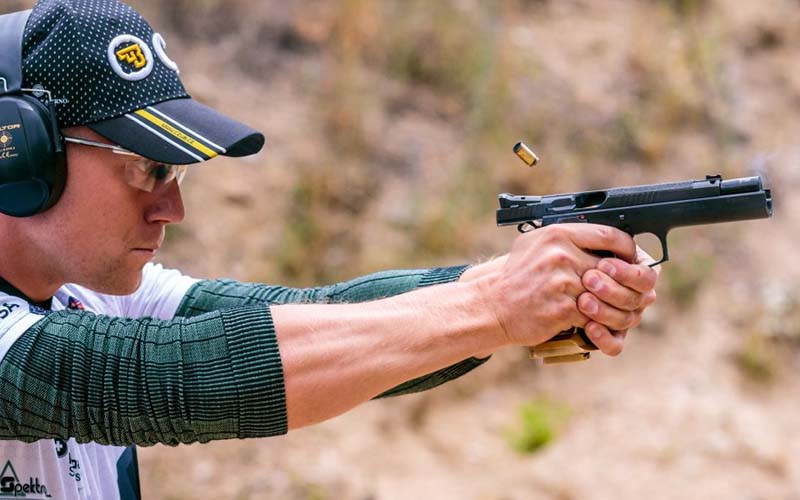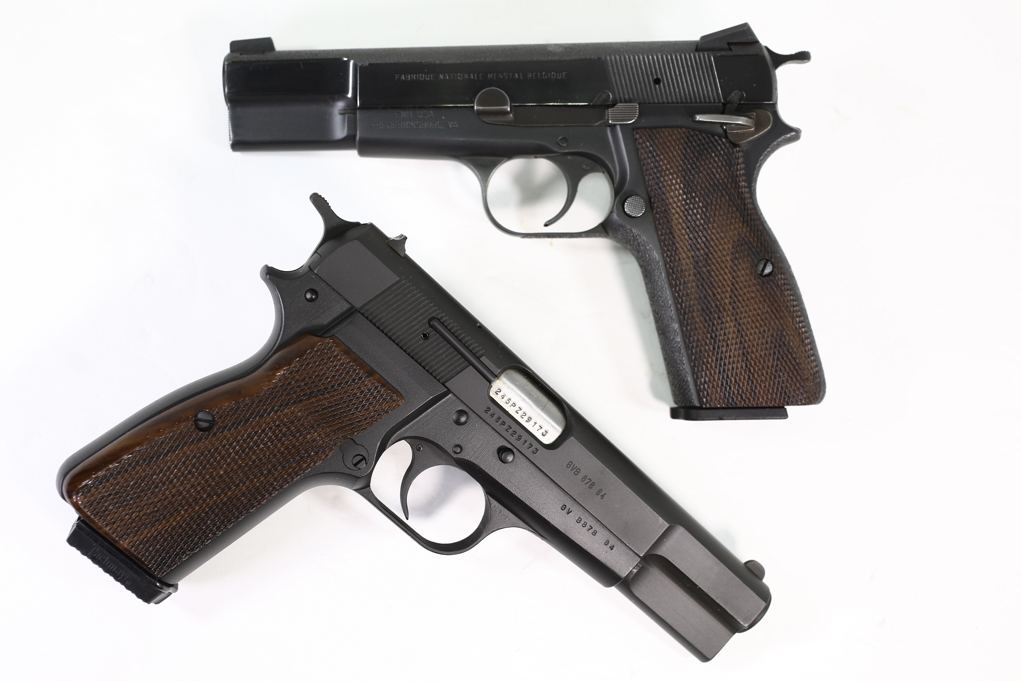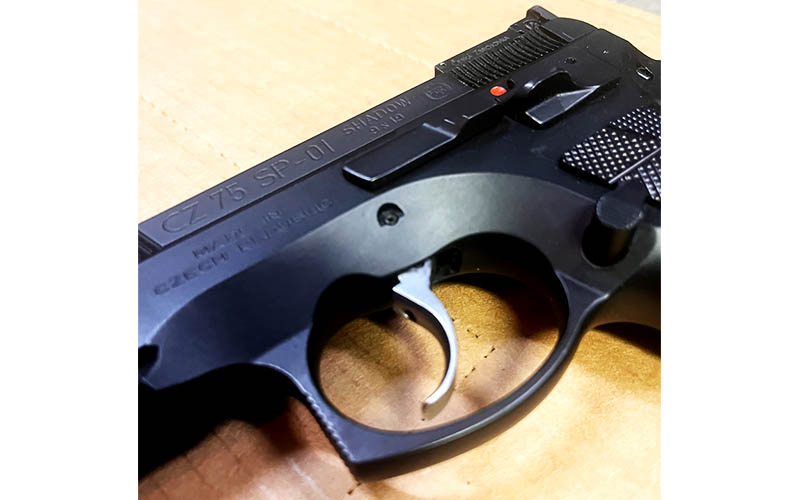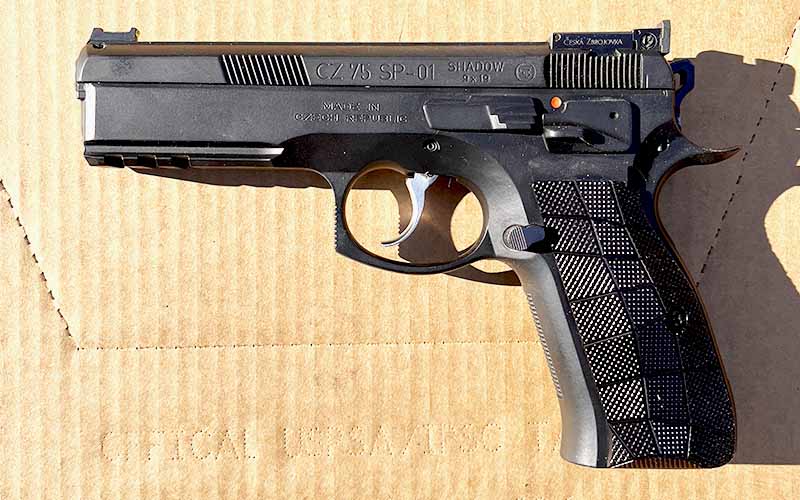
The author takes a closer look at the past, present and future of the CZ 75, the timeless Czech wonder nine.
If you show up at any pistol match today—whether it’s IDPA, USPSA, IPSC or Steel Challenge—I’d wager you’d find a CZ in many, many holsters. In fact, I’d hazard that the top shooters at your match, at least half of them, are running a CZ of some flavor. This includes my own holster—not that I’d shout from the rooftops that I’m a “top shooter.”
The data backs this up, too. Participant survey data of USPSA Production division handguns at the 2020 Nationals shows that 45 percent of shooters were running some kind of CZ, and plenty of others were using pistols based on the CZ 75 like the EAA Tanfoglio Witness Stock 2. It’s easy to see why they’re so popular when you consider that the CZ Team alone took 9 medals at the 2022 IPSC Handgun World Shoot XIX.

So, this got me to thinking—how did this pistol rise to such prominence in competitive pistol shooting? Compared to action movie icons like the Beretta 92, the CZ 75 is relatively unknown, nor does it have the history or the zealous followers that John Moses Browning’s 1911 has. In fact, even my brother-in-law who is of Czech descent and in law enforcement had never heard of the CZ 75. This is a shame, as the pistol really deserves more respect and recognition.
To help remedy that, today we’ll be talking about the CZ 75’s origins, how it evolved into a world-class competition pistol and where it’s going.
Origins Of The CZ 75
Before we can begin any discussion on the present or future, we need to talk about the origins of “Česká Zbrojovka,” a name that roughly translates to “Czech armory” and is what CZ stands for.
The CZ saga dates all the way back to 1935 when an armament factory was established in the former Czechoslovakia in Uhersky Brod (CZUB), as far as possible from the western borders of Nazi Germany. Located in the southeast of Moravia, this factory was primarily tasked with making aircraft machine guns, weapons that obviously saw plenty of use in the impending world wars. In 1949, after WWII, the joint-stock company Česká zbrojovka was nationalized and gradually became the main Czechoslovak manufacturer of small arms such as Sa vz. 23 submachine guns and vz. 58 rifles. By 1962, the company was producing the iconic vz. 61 Škorpion machine pistol, a gun that’s almost certainly seen more action in movies and video games throughout the years than it ever has in real life.
Then, in the late 1960s, development of the CZ 75 began by brothers Josef and František Koucký, the two stars of post-war CZ small arms design. Legend has it that František Koucký was offered the job to develop a new 9mm handgun, but because he had recently officially retired from CZUB, this time he had carte blanche on the project. This gave him the freedom to both completely innovate with fresh ideas as well as borrow from whatever existing designs he wanted, and he took full advantage of both.

Result? The Koucký brothers’ design was so innovative that it’s still relevant today almost 50 years later. Cleverly, the brothers only used their surname on the CZ 75 patents so they could both share the glory. This, also, may have contributed to the patent debacle, but we’ll discuss that more later.
The CZ 75 Is Born
When the Koucký brothers began work on the CZ 75, Czechoslovakia’s service pistol cartridges were the same as those of other Warsaw Pact countries (namely, 9x18mm Makarov and 7.62x25mm Tokarev), the CZ 75 (being a 9x19mm pistol) was initially intended as an export-only firearm.
“The choice of a 9mm Parabellum was clear from the start,” Lynn Twiss, Marketing Director of CZ-Dan Wesson said. “At first, there was talk of it being a small pistol for self-defense. An exclusive distributor abroad then demanded a large-capacity magazine like the one that came with the FN HP 35, and finally, a request for an SA/DA trigger and firing mechanism. More detailed development was left to the designer. The explanation for its design was simple: it was to be a product for export to the West, where the concept of the Wonder Nines was taking hold.”
Despite being designed in the early 70s, the pistol did not reach the Czech civilian market until 1985 and was only officially adopted by its home country’s armed forces in 1989.
Then in 1986, CZ introduced the CZ 85—an ambidextrous model with a safety and slide stop on either side. From there, the CZ 75 platform underwent minimal changes, for the most part, until the early 2000s when CZ began to turn its eye toward competition shooting.
Emulation, Innovation And Patents
They say that emulation is the greatest form of flattery, and in this way, the CZ 75 may be one of the most flattered guns in the industry since its design has been copied by over a half-dozen other pistol manufacturers. However, that’s not to say that the CZ 75 design itself wasn’t inspired by others.
Semi-autos in general date back to the early 1890s. By WWI, autoloading pistols like the German Luger and the Colt 1911 were in general use by armed forces. John Moses Browning, inventor of the famous and aforementioned 1911, died in 1926 while he was developing the Browning Hi-Power or P35. Anybody just looking at the Hi-Power can see the resemblance to the CZ 75, so it’s no wonder that they function similarly too. Both pistols use a short-recoil, locked-breech system with a linkless cam locking system.

“The [Hi-Power] 35 was just one of the many inspirations for František Koucký,” Twiss said, regarding the 75's design. “His way of thinking was perhaps best summed up in 1979 by the legendary Jeff Cooper: ‘The Czech 75 — called the Brünner Pistol in Germany — may be considered the ultimate development of the Browning/Colt system. It takes the best Browning features, combines them with a couple of better innovations found in the best French and Swiss designs, and adds a few original touches of its own to put the whole together in the neatest package in the world.'”
“We innovate and develop our guns in a variety of ways. Sometimes we build on previous models. Sometimes we try new design paths. But one thing always remains the same: the customer, his needs and wishes are essential for us. It may sound like a cliché, but that's exactly what makes great pistols, like the Shadow.”
Three years after the Browning Hi-Power’s release, the Walther P38 was invented. This pistol featured an open-breech design, much like what the Beretta 92 and some similar pistols adopted, but also a DA/SA trigger and a decocker—a standard feature on the CZ 75BD, SP-01 Tactical, CZ P-01 and many other models.
All of that to say, firearms borrow from other firearms. However, many other designs have cropped up that are exact clones of or copies heavily inspired by the famous CZ 75. There’s the IMI/IWI Jericho 941 (aka Magnum Research Baby Eagle), Tanfoglio TZ-75, SAR 2000, EAA Witness and even the Sphinx Systems Sphinx 2000 just to name a few. All of these are CZ 75 copies of varying degrees.

Why are there so many copies made outside of its birthplace? Much of it has to do with the complexity of Czech patent law, secret patents and the fact that the CZ 75 was designed for export.
František Koucký was very concerned about patent protection for his designs, and this gun was no exception as it was covered by four patents. Due to potential interest from the armed forces, they were first filed as secret patents. This is not unusual, as this practice is utilized for inventions all over the world, including in the U.S.
In 1979, it was decided to declassify all four patents for the CZ 75. Long story short, something went wrong, and CZ never managed to secure world patent protection, leading to a free-for-all of global manufacturers making use of the design for free.
Despite this, CZ is still going strong today, and it never stopped innovating on the CZ 75 design as it continued to release new models. Even with the market being flooded with clones since before the original manufacturer could break into the international market, the company’s pistols continue to sell extremely well around the world.
While originally designed as a military pistol, however, most of the new models based on the CZ 75 have trended towards competition shooting in recent years. Let’s dig into how this transition came to pass.

The CZ 75 And Its Rise In Competitive Shooting Sports
For years, CZ sensed the potential of the CZ 75 pistol, but a lot of credit for building CZ’s shooting team goes to Czech Canadian Milan Trkulja, an IPSC shooter, judge and expert in shooting disciplines. He was one of the driving forces that convinced and motivated CZ to found a shooting team, also marking the start of sport pistol development based on the CZ 75. This is where you can find the origins of CZ’s line of competition pistols.

The father, or rather grandfather, of these guns is the CZ SP-01. While it was also originally created with military and law enforcement use in mind, its features were quickly recognized as being beneficial to competition shooting as well. One was even used by Adam Tyc to take 1st place at the 2005 IPSC championship, World Shoot XIV around the time of its release.
To build the SP-01, CZ essentially took the P0-1 (an aluminum-framed, compact model already certified by NATO) and gave it a full-size steel frame and slide and an extended 18-round magazine while retaining the P0-1’s accessory rail. Following the gun’s positive reception in sports shooting circles, CZ clearly saw a new potential market and began cooking up designs to cater to them. In the two decades since, CZ has released a litany of excellent competition-focused pistols, but all are still based on the original CZ 75 at heart.

Lynn Twiss also shared this anecdote with me about how the original CZ SP-01 Shadow was born. “The result was a huge surprise, as well as a disappointment, since the pistol seemed too robust, heavy, and unsuitable for normal carry. It was supposed to be for special forces use, but we found it completely useless. This was perhaps the reason why no manufacturer had tried to make an all-steel pistol with slots for a flashlight. However, the real potential of the pistol did not go unnoticed by the aforementioned Milan Trkulja. He wanted to lend the gun he made to IPSC sport shooters for a few days, so they could test it. Instead of returning it after a couple of weeks, he kept it for three months and confirmed it would be a force to be reckoned with in the Production division. After a few minor modifications, the pistol called CZ 75 SP-01 SHADOW was fitted for our shooting team, who immediately started winning titles with it. The success of our shooters and their tools began to be noticed by other shooters and other manufacturers. There are similar concepts on the market today, but despite this fact, we consistently prove at each and every competition that our technology and know-how are far ahead of competing brands.”
Parting Shot
CZs have something of a cult following, but I say that with love because in many ways I’ve sipped the Kool-Aid, too. They are well-built, high-capacity, exceptionally accurate, wildly ergonomic pistols that have ample models and modifications to choose from.
My recommendation is if you haven’t had the chance to shoot a CZ yet, you should. Even just holding one, you can tell it’s an extension of your hand, and couple that with some custom, aftermarket grips and you no longer have a pistol—you have an appendage. Next time you’re at the gun shop, if you see one, pick it up.

The original CZ 75 is not only a classic Cold War-era military pistol, but it remains an excellent shooter. That said, the design has only improved in terms of shootability since the company started focusing on the competition market. Whether you’re looking for a full-size target pistol, a compact carry gun or something in between, there’s a flavor of CZ 75 out there ready to do the job.
More Classic Military Guns:
- Why The Mauser C96 “Broomhandle” Still Looms Large
- The Makarov And Other 9x18mm Pistols
- Nagant Revolver: Unique Relic From Behind The Iron Curtain
- M1917 Enfield: The Unofficial U.S. Service Rifle
- Browning Automatic Rifle: The Gun That Changed the Infantry

Next Step: Get your FREE Printable Target Pack
Enhance your shooting precision with our 62 MOA Targets, perfect for rifles and handguns. Crafted in collaboration with Storm Tactical for accuracy and versatility.
Subscribe to the Gun Digest email newsletter and get your downloadable target pack sent straight to your inbox. Stay updated with the latest firearms info in the industry.

![Best Concealed Carry Guns In 2025 [Field Tested] Wilson Combat EDC X9S 1](https://gundigest.com/wp-content/uploads/Wilson-Combat-EDC-X9S-1-324x160.jpg)


![Best 9mm Carbine: Affordable PCCs [Tested] Ruger Carbine Shooting](https://gundigest.com/wp-content/uploads/Ruger-Carbine-Shooting-100x70.jpg)
![Best AR-15: Top Options Available Today [Field Tested] Harrington and Richardson PSA XM177E2 feature](https://gundigest.com/wp-content/uploads/Harrington-and-Richardson-PSA-XM177E2-feature-100x70.jpg)

I have never carried the CZ75 as an EDC. I own one (9mm) and have experience with it on the range, having enjoyed it for some years now in that capacity.
Some years ago I was gifted a IMI Baby Desert Eagle, compact, in .40SW. while doing some work overseas. I didn’t make the CZ connection until sometime later. What I found remarkable about the platform was the Hexagon type rifling used in the barrel. This makes this platform extremely accurate, far more so than many other platforms!
I have always been curious as to why this type of rifling is not used or found in other hand
platforms, particularly, in competition platforms. It would seem a commonsense choice given that it seems to provide very accurate shot placement. I have found little information on this topic.
I have carried the BDE compact off and on for years, it being small, comfortable, easily maintained, and very accurate for such a small pistol. I later picked up an IMI BDE Full Frame in .45 in a trade with an acquaintance overseas for a Delta Elite 10mm which he had wanted for some time, I am very fond of both these IMI BDE’s! Both are all steel, extremely well balanced, with a very intuitive feel, SA/DA, fair sight picture and well built.